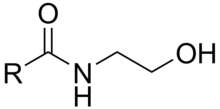N-Acylethanolamine

An N-acylethanolamine (NAE) is a type of fatty acid amide formed when one of several types of acyl group is linked to the nitrogen atom of ethanolamine. These amides conceptually can be formed from a fatty acid and ethanolamine with the release of a molecule of water, but the known biological synthesis uses a specific phospholipase D to cleave the phospholipid unit from N-acylphosphatidylethanolamines.[1] Another route relies on the transesterification of acyl groups from phosphatidylcholine by an N-acyltransferase (NAT) activity. The suffixes -amine and -amide in these names each refer to the single nitrogen atom of ethanolamine that links the compound together: it is termed "amine" in ethanolamine because it is considered as a free terminal nitrogen in that subunit, while it is termed "amide" when it is considered in association with the adjacent carbonyl group of the acyl subunit. Names for these compounds may be encountered with either "amide" or "amine" varying by author.[2]
Examples of N-acylethanolamines include:[3]
- Anandamide (N-arachidonoylethanolamine; NAE 20:4) or arachidonlyethanolamine (AEA) is the amide of arachidonic acid (20:4 ω-6) and ethanolamine. It is the ligand of both cannabinoid receptors and vanilloid receptor that attenuates pain sensation.[4][5][6][7]
- N-Palmitoylethanolamine is the amide of palmitic acid (16:0) and ethanolamine. It has anti-inflammatory activity and also attenuates pain sensation.[7][8][9] in mammals. NAE 16:0 has also been identified in plants including corn, and seeds of cotton, okra, tomato, castor bean, soya bean and peanuts,[10] but its physiological functions remain unknown.[11]
- N-Oleoylethanolamine is the amide of oleic acid (18:1) and ethanolamine. It has anorexic effects and enables fat breakdown by stimulating PPAR-alpha.[12] In plants NAE 18:1 is present abundantly in dry seeds and levels decline during seed imbibition,[10][13] but its physiological functions are yet to be elucidated.
- N-Stearoylethanolamine is the amide of stearic acid (18:0) and ethanolamine. It has pro-apoptotic activity. It operates independently of the known cannabinoid and vanilloid receptors targeted by anandamide.[12]
- N-Docosahexaenoylethanolamine is the amide of docosahexaenoic acid (22:6) and ethanolamine. It has anti-proliferative effects on prostate cancer cell lines and promotes synaptogenesis.[14][15]
These bioactive lipid amides are generated by the membrane enzyme NAPE-PLD, and natural bile acids regulate this essential process.[16]
References
- ↑ Okamoto, Y.; Morishita, J.; Tsuboi, K.; Tonai, T.; Ueda, N. (2004). "Molecular characterization of a phospholipase D generating anandamide and its congeners.". The Journal of Biological Chemistry. 279 (7): 5298–5305. doi:10.1074/jbc.M306642200. PMID 14634025.
- ↑ For example, note synonyms in PubChem for oleoylethanolamine.
- ↑ The list and references provided are based on background discussion in Okamoto Y, Morishita J, Tsuboi K, Tonai T, Ueda N (February 2004). "Molecular characterization of a phospholipase D generating anandamide and its congeners". J. Biol. Chem. 279 (7): 5298–305. doi:10.1074/jbc.M306642200. PMID 14634025.
- ↑ WA Devane, L Hanus, A Breuer, RG Pertwee, LA Stevenson, G Griffin, D Gibson, A Mandelbaum, A Etinger, and R Mechoulam; Hanus; Breuer; Pertwee; Stevenson; Griffin; Gibson; Mandelbaum; Etinger; Mechoulam (1992). "Isolation and structure of a brain constituent that binds to the cannabinoid receptor". Science. 258 (5090): 1946–1949. Bibcode:1992Sci...258.1946D. doi:10.1126/science.1470919. PMID 1470919.
- ↑ Di Marzo (1998). "'Endocannabinoids' and other fatty acid derivatives with cannabimimetic properties: biochemistry and possible physiopathological relevance.". Biochimica et Biophysica Acta. 1392 (2–3): 153–75. doi:10.1016/s0005-2760(98)00042-3. PMID 9630590.
- ↑ Di Marzo; De Petrocellis, L; Fezza, F; Ligresti, A; Bisogno, T (2002). "Anandamide receptors". Prostaglandins, leukotrienes, and essential fatty acids. 66 (2–3): 377–91. doi:10.1054/plef.2001.0349. PMID 12052051.
- 1 2 Calignano; La Rana, G; Giuffrida, A; Piomelli, D (1998). "Control of pain initiation by endogenous cannabinoids". Nature. 394 (6690): 277–81. Bibcode:1998Natur.394..277C. doi:10.1038/28393. PMID 9685157.
- ↑ Lambert; Vandevoorde, S; Jonsson, KO; Fowler, CJ (2002). "The palmitoylethanolamide family: a new class of anti-inflammatory agents?". Current medicinal chemistry. 9 (6): 663–74. doi:10.2174/0929867023370707. PMID 11945130.
- ↑ Rahman, Iffat Ara Sonia; Tsuboi, Kazuhito; Uyama, Toru; Ueda, Natsuo (2014-08-01). "New players in the fatty acyl ethanolamide metabolism". Pharmacological Research. Lipid amide signaling: regulation, physiological roles and pathological implications. 86: 1–10. doi:10.1016/j.phrs.2014.04.001.
- 1 2 Chapman, Kent; Venables, Barney; Markovic, Robert; Blair Jr, Raymond; Bettinger, Chris (1999). "N-Acylethanolamines in Seeds. Quantification of Molecular Species and Their Degradation upon Imbibition". Plant Physiology. 120 (4).
- ↑ Motes, Christy M.; Pechter, Priit; Yoo, Cheol Min; Wang, Yuh-Shuh; Chapman, Kent D.; Blancaflor, Elison B. (2005-12-12). "Differential effects of two phospholipase D inhibitors, 1-butanol and N-acylethanolamine, on in vivo cytoskeletal organization and Arabidopsis seedling growth". Protoplasma. 226 (3-4): 109–123. doi:10.1007/s00709-005-0124-4. ISSN 0033-183X.
- 1 2 Rodríguez De Fonseca; Navarro, M; Gómez, R; Escuredo, L; Nava, F; Fu, J; Murillo-Rodríguez, E; Giuffrida, A; Loverme, J (2001). "An anorexic lipid mediator regulated by feeding". Nature. 414 (6860): 209–12. doi:10.1038/35102582. PMID 11700558.
- ↑ Kilaru, Aruna; Tamura, Pamela; Isaac, Giorgis; Welti, Ruth; Venables, Barney J.; Seier, Edith; Chapman, Kent D. (2012-06-07). "Lipidomic analysis of N-acylphosphatidylethanolamine molecular species in Arabidopsis suggests feedback regulation by N-acylethanolamines". Planta. 236 (3): 809–824. doi:10.1007/s00425-012-1669-z. ISSN 0032-0935. PMC 3579225
 . PMID 22673881.
. PMID 22673881. - ↑ Brown I, Cascio MG, Wahle KW, Smoum R, Mechoulam R, Ross RA, et al. (2010). "Cannabinoid receptor-dependent and -independent anti-proliferative effects of omega-3 ethanolamides in androgen receptor-positive and -negative prostate cancer cell lines.". Carcinogenesis. 31 (9): 1584–91. doi:10.1093/carcin/bgq151. PMC 2930808
 . PMID 20660502.
. PMID 20660502. - ↑ Kim HY, Spector AA, Xiong ZM (2011). "A synaptogenic amide N-docosahexaenoylethanolamide promotes hippocampal development.". Prostaglandins Other Lipid Mediat. 96 (1-4): 114–20. doi:10.1016/j.prostaglandins.2011.07.002. PMC 3215906
 . PMID 21810478.
. PMID 21810478. - ↑ Magotti P, Bauer I, Igarashi M, Babagoli M, Marotta R, Piomelli D, Garau G (Dec 2014). "Structure of Human N-Acylphosphatidylethanolamine-Hydrolyzing Phospholipase D: Regulation of Fatty Acid Ethanolamide Biosynthesis by Bile Acids". Structure. 24 (3): 598–604. doi:10.1016/j.str.2014.12.018. PMID 25684574.